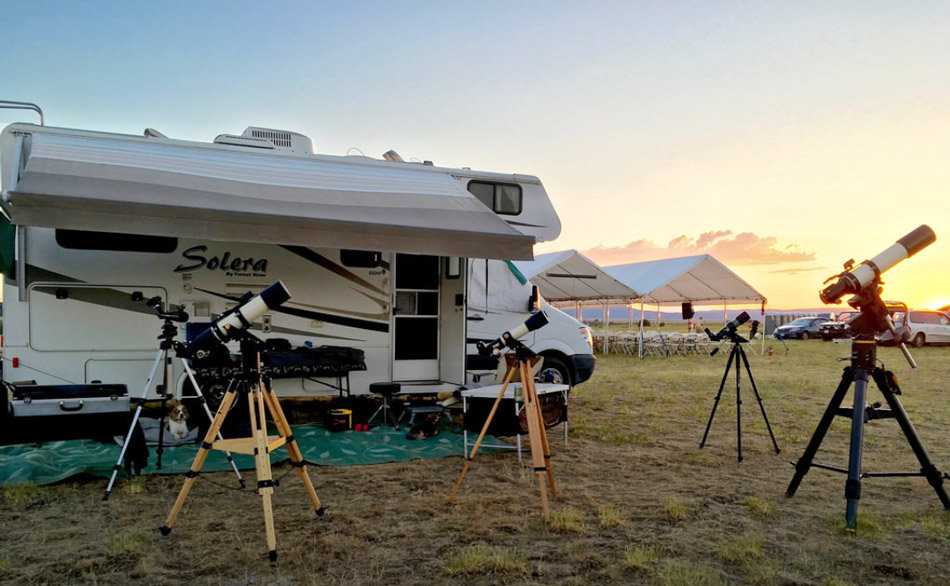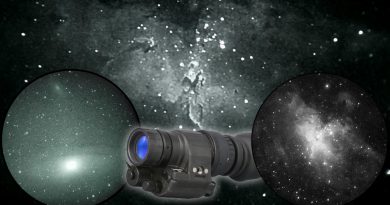Tele Vue-76: Imaging the Skies over Washington!
Andrew Thomas has been posting beautiful wide-field sky images on his Flickr feed. He’s imaging with one of our smaller scopes, the highly portable and capable Tele Vue-76 APO refractor! Here’s an image made by Andrew with this scope during the Great American Eclipse in August 2017.
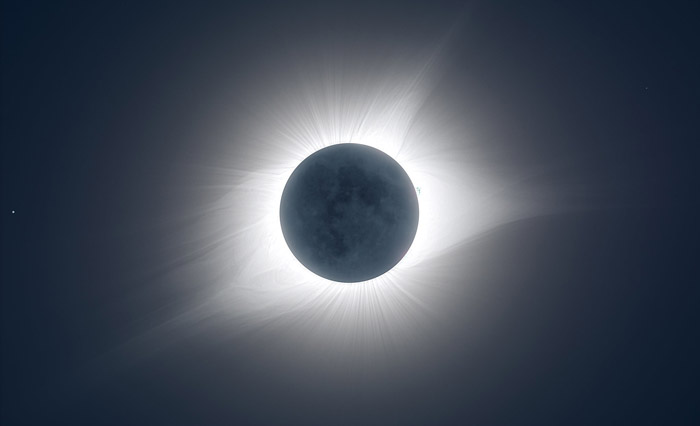
“In this photo, the detailed structure of the solar corona and reflected Earthshine illuminating the surface of the Moon is revealed in this HDR composite of images taken at different exposure lengths. Regulus, the brightest star in Leo, is visible to the far left …”.
Imaged with Tele Vue-76mm APO refractor with Nikon D7100 DSLR camera riding on an iOptron iEQ45 Pro mount. Capture software was Eclipse Orchestrator v3.7. 4 sets of exposures at 1/1600, 1/400, 1/100, 1/25, 1/6, 1/3, and 6/10 sec @ ISO 200, stacked to reduce noise and enhance detail. Location: Madras, Oregon.
Andrew gave us permission to re-post these photos on our blog.
I’m glad you enjoy the images I’ve been able to capture with the Tele Vue-76. It’s a wonderful scope for both visual use and imaging. I don’t think I’ll ever give it up!
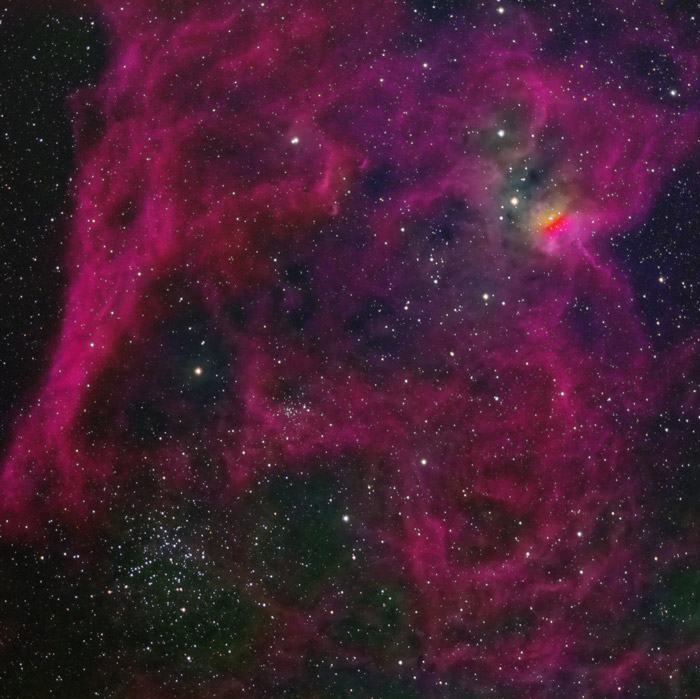
“IC417, sometimes called the Spider Nebula, lies in the constellation Auriga. This image was taken from Seattle over a couple of clear nights in late October 2019. Narrowband Ha, OIII and SII filters were used to capture the nebulosity, which was later combined with RGB data for the stars.”
Imaged with Tele Vue-76 APO refractor with Tele Vue TRF-2008 0.8x Reducer/Flattener (converts TV-76 to 380mm f/5.0 for flat field, fast photography) into QSI 683wsg (3326×2504 sensor) camera. Mount used was iOptron iEQ45 Pro. Exposure was Hydrogen-alpha: 19 x 900 sec (bin: 1×1), OIII 10 x 900 sec (bin: 2×2), SII: 8 x 900 sec (bin: 2×2), Red / Green / Blue: 5 x 120 sec (bin: 1×1) each. Software: PixInsight, StarNet++, and PaintShop Pro. “
I’ve been a huge fan of Tele Vue ever since buying my first “real” eyepiece, a 24mm Tele Vue Widefield, back in 1985. I purchased my Tele Vue-76 in 2015 at the Table Mountain Star Party from Sunriver Nature Center and Observatory to use as a high quality, portable visual scope and was immediately impressed by the wide-field and pinpoint sharp views. I’d recently gotten into astrophotography, so it wasn’t long before a camera found its way onto the back of the Tele Vue-76. The same qualities that make it a great visual scope translate over to imaging. After several years of use, I’m still wowed by what this little scope can deliver.
In this next example, brilliant stellar jewels light up colorful clouds and reveal dark clumps of dust in this image of the Rho Ophiuchi cloud complex — one of the closest stellar nurseries to Earth.
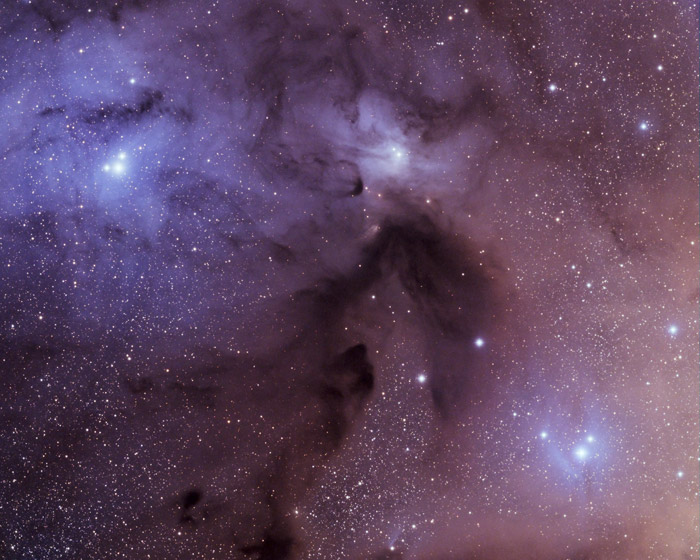
“Rho Ophiuchi is a multiple star system embedded in a large, star-forming cloud complex of gas and dust in the constellation Ophiuchus. This image was captured under dark skies at the Golden State Star Party near Adin, CA.”
Imaged with Tele Vue-76 APO refractor with Tele Vue TRF-2008 0.8x Reducer/Flattener (converts TV-76 to 380mm f/5.0 for flat field, fast photography) into QSI 683wsg (3326×2504 sensor) camera. Mount used was iOptron iEQ45 Pro. Exposure was Luminance: 70 min (14 x 3 min) 1×1, Red / Green / Blue: 35 min (7 x 5 min) 2×2 each.”
For imaging, I eventually added a Feather Touch focus motor from Starlight Instruments, but the Tele Vue-76 is otherwise still in its stock configuration. The 2″ focuser has consistently proven more than capable of holding a cooled CCD camera and filter wheel. I highly recommend the Tele Vue-76 to anyone interested in astronomy or astrophotography.
This image of a “ghost” floating in the void was made by the glow of Hydrogen-alpha light. The “ghostly” gas is bombarded by ultraviolet light from the star above it. This energizes the hydrogen atoms in the cloud to glow. This image has to be viewed full-size to be appreciated (click image).
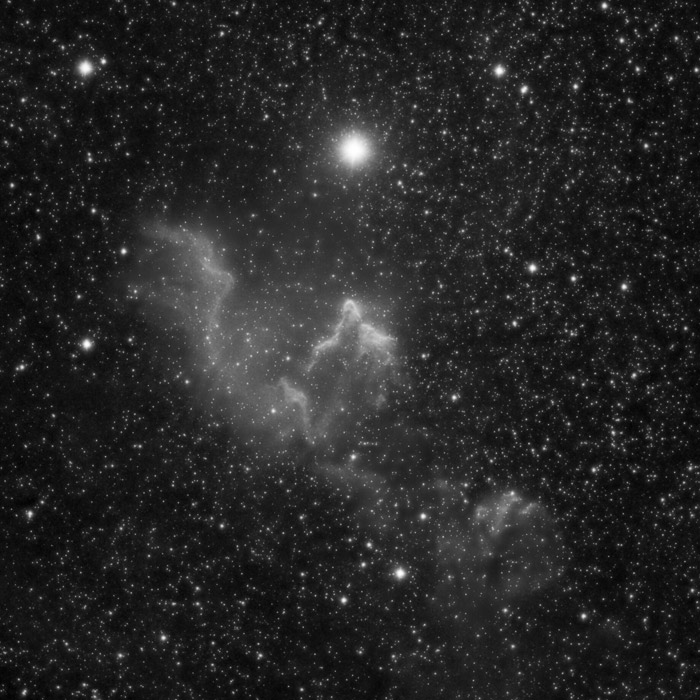
“IC63 (middle) and IC59 (upper-left) are emission nebulae adjacent to the bright star Gamma Cassiopeiae in the constellation Cassiopeia. IC63 is often called the Ghost of Cassiopeia, since, well, it kind of looks like a ghost. In an appropriate coincidence for the subject, this narrowband image was captured on Halloween night from Seattle, WA.”
Imaged with Tele Vue-76 APO refractor with Tele Vue TRF-2008 0.8x Reducer/Flattener (converts TV-76 to 380mm f/5.0 for flat field, fast photography) into QSI 683wsg (3326×2504 sensor) camera. Mount used was iOptron iEQ45 Pro. Exposure was through Astrodon Hydrogen-alpha, 5nm filter for 2.5 hours (10 x 900 sec).
Tele Vue-76 is a 76-mm diameter objective, 480mm focal length, f/6.3, APO (Doublet) refractor that combines compact size with APO optical performance and 2″ eyepiece capability. The maximum field-of-view is an almost binocular-like 5.5° with our 41-mm Panoptic (11.7x) or 55mm Plössl (8.7x). The 5.0° field-of-view of the 31mm Nagler (15.5x) is another option for wide-field/self-finder use. The 2″, 10:1 dual speed, rack-and-pinion focuser features dual tension adjustment screws on the drawtube and dual lock screws on the end-ring. The OTA includes a sliding metal dew shield and screw-on metal lens cap. Available in tough, durable, powder-coated ivory or green tube colors. A custom-fitted padded case with room for accessories is included. The latitude of power and field afforded by this scope allows you to explore astronomical, spotting, and birding targets with the same scope. Available in ivory or green tube, all Tele Vue telescopes come with a 5-year Limited Warranty.
 Optional Tele Vue-76 Accessory Package (TVP-3066) adds 3” tube ring- with mounting threads, a telescope balance aid bar that allows for a greater range of shifting the OTA over the mount (great when trying to balance binocular viewers or heavy eyepieces and cameras), 2″, 90° Everbrite dielectric (99%, 1/10-wave) coated mirror diagonal with 1¼” eyepiece adapter and brass clamp rings, and 18.2-mm DeLite eyepiece with 20-mm eye-relief that yields 2.3° true field of view at 26x in the Tele Vue-76.
Optional Tele Vue-76 Accessory Package (TVP-3066) adds 3” tube ring- with mounting threads, a telescope balance aid bar that allows for a greater range of shifting the OTA over the mount (great when trying to balance binocular viewers or heavy eyepieces and cameras), 2″, 90° Everbrite dielectric (99%, 1/10-wave) coated mirror diagonal with 1¼” eyepiece adapter and brass clamp rings, and 18.2-mm DeLite eyepiece with 20-mm eye-relief that yields 2.3° true field of view at 26x in the Tele Vue-76.
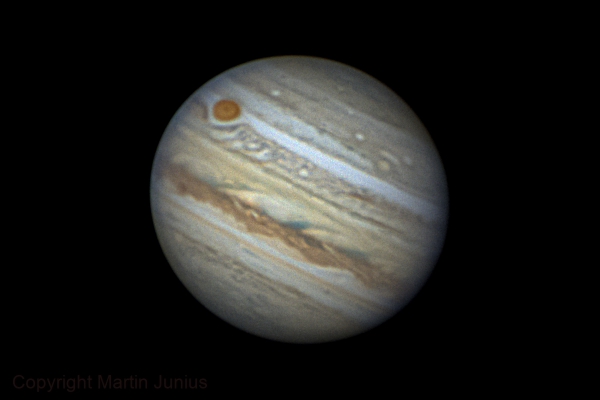
Image acquisition by Martin Junius and Michael Mushardt. (Michael also owns the Powermate used for imaging). Image processing by Martin Junius. The IAS Gamsberg observatory and the telescope used for imaging are owned by their association: Internationale Amateursternwarte e.V. (International Amateur Observatory).
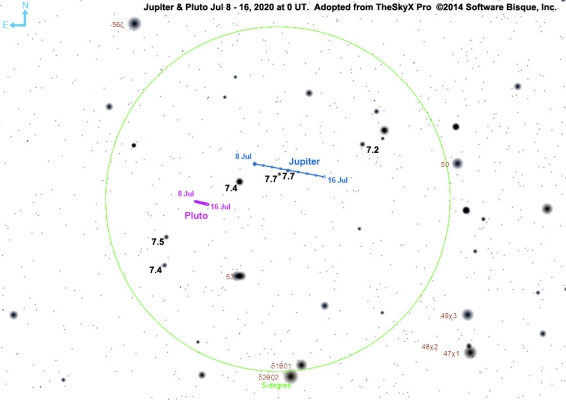
- More Andrew Thomas images on Flickr.
- For images of southern hemisphere targets made with this scope see the Tele Vue-76: Imaging the Southern Hemisphere blog post.
- TV-76 nature images on the “Image” tab of our Birding site.
- Tele Vue-76 webpage (mobile site).
- Small scope Accessory Package blog post.
Did you observe, sketch, or image with Tele Vue gear? We’ll like your social media post on that if you tag it #televue and the gear used. Example:
#televue #tv85 #ethos #jupiter
Do you want your Tele Vue images re-posted on Tele Vue Optics’ Social Media accounts? Use this hashtag for consideration:
#RPTVO





